These intelligent birds are known for their remarkable ability to mimic over 1,000 words and phrases, making them one of the most talkative species in the avian world. With patience and the right approach, you can transform even a shy bird into a vocal companion, just like Dolly, who learned to respond to commands like “scratch” and “step up”.
Speech training strengthens the bond between you and your feathered friend. Using positive reinforcement, such as treats and praise, helps build trust and encourages learning. Starting with simple words like “hello” or their name can set the foundation for more advanced phrases later.
Success comes from consistency and understanding your bird’s unique personality. Breaking training into small steps ensures steady progress while keeping sessions fun and engaging. For more tips, check out this helpful guide on effective techniques.
Key Takeaways
- These parrots can mimic over 1,000 words with proper encouragement.
- Positive reinforcement builds trust and speeds up learning.
- Start with simple words and gradually introduce more phrases.
- Consistency and patience are key to long-term success.
- Training strengthens the bond between you and your bird.
Why African Grey Parrots Are Exceptional Talkers
Few birds can match the speech abilities of these feathered geniuses. Their talent isn’t just mimicry—it’s a blend of biology and brainpower.
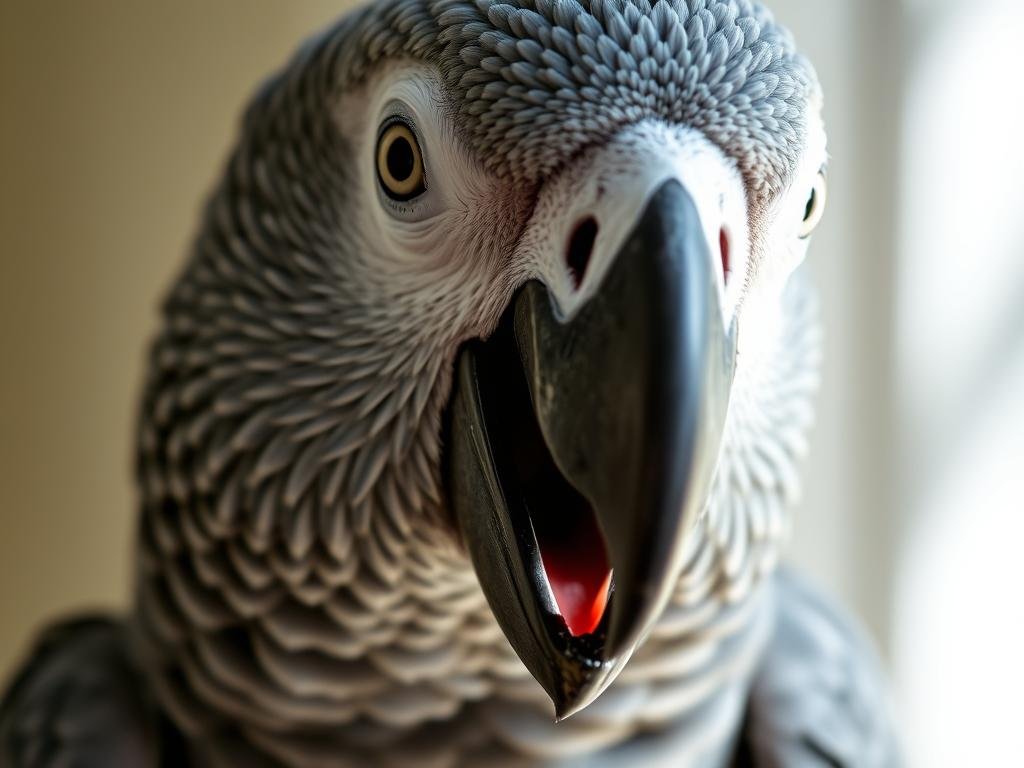
Their Natural Ability to Mimic Sounds
A specialized syrinx (vocal organ) lets them replicate sounds with precision. From door creaks to phone rings, their accuracy rivals human speech.
Studies show they process noises before vocalizing, often waiting 12+ months to start talking. This delayed response ensures perfect imitation.
How Intelligence Plays a Role
Their cognitive skills let them use words contextually. For example, Dolly learned to say “Wookywoo” only when her toy was nearby.
| Feature | Parrots | Humans |
|---|---|---|
| Learning Method | Incremental repetition | Grammar rules |
| First Words | ~12 months | ~12 months |
| Contextual Use | Yes (e.g., greetings) | Yes |
Social interaction fuels their learning. Regular chats and rewards speed up their ability to pick up phrases.
African Grey Talk Training: Guide to Success
Starting speech training at a young age maximizes a parrot’s natural abilities. Studies show younger birds absorb sounds faster, making them ideal candidates for learning. Aim for two 20-minute sessions per time to keep engagement high without overwhelming your bird.
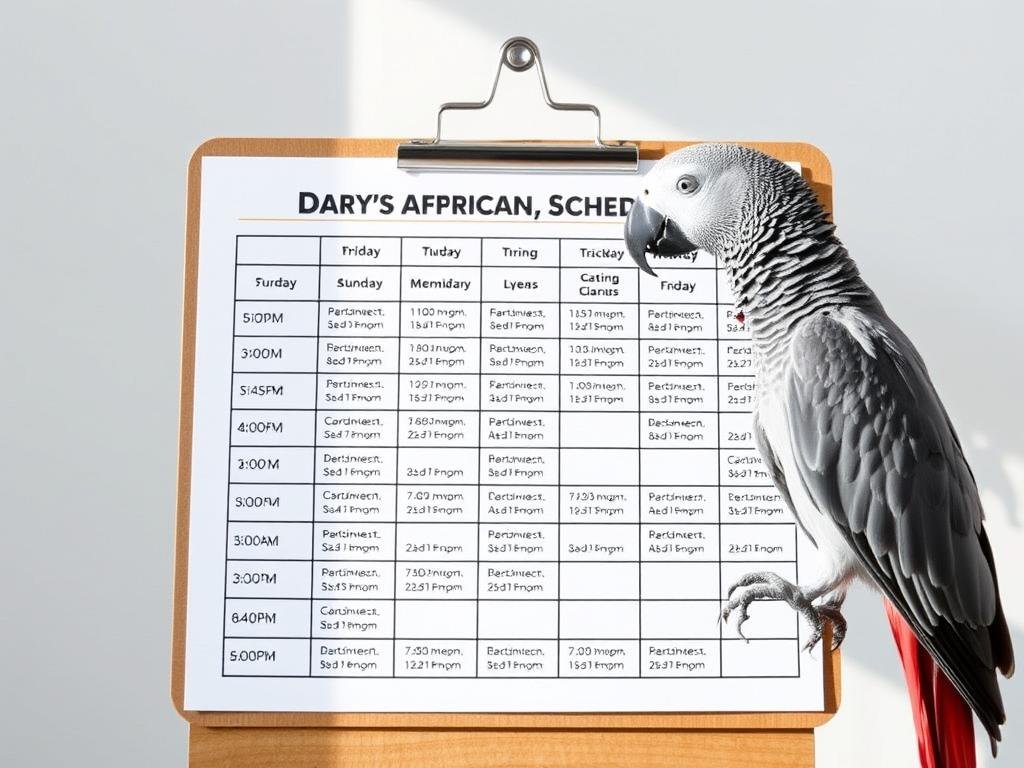
Starting Early for Best Results
Young parrots are more receptive to new sounds and phrases. Begin with simple words like “hello” or their name, repeating them 5–6 times per session. Patience is key—some may take weeks to respond, as seen with Dolly’s progress.
The Power of Consistency in Training
Daily repetition builds trust and reinforces learning. Expert Barbara Heidenreich recommends gradual trust-building over weeks, pairing words with treats or praise. Avoid marathon sessions; frustration hinders progress.
| Week | Focus | Goal |
|---|---|---|
| 1–2 | Bonding & Simple Words | Responds to name |
| 3–4 | Basic Commands | Mimics 1–2 words |
| 5–6 | Phrases & Context | Uses words appropriately |
Success comes from steady effort. Celebrate small wins, like Dolly stepping up by week 6, to keep motivation high.
Essential Tools for Effective Training
The right tools can make or break your parrot’s learning experience. From clickers to target sticks, these devices streamline behavior shaping and boost interaction.
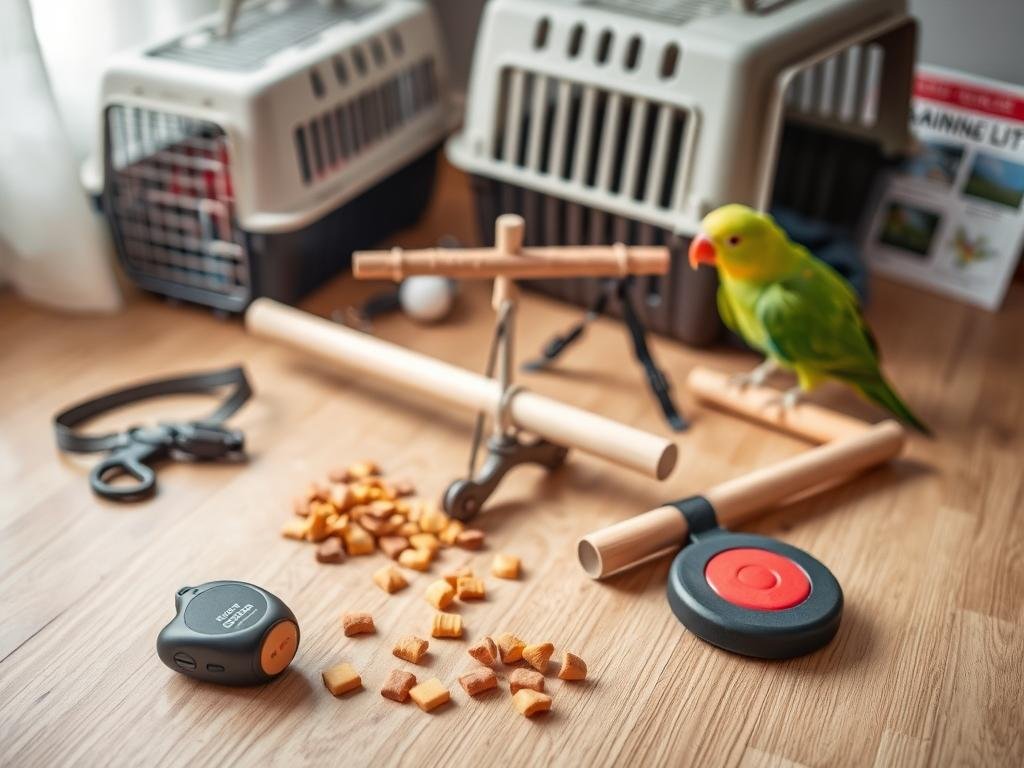
Clicker Training Basics
Clickers mark desired behavior, similar to dog obedience methods. The sharp sound instantly signals success, helping your parrot connect actions to rewards.
Start with simple tasks, like touching a stick. Pair each click with a treat—Dolly responded best to tactile rewards over food.
Using Target Sticks to Encourage Interaction
Target sticks teach commands like “step up.” Begin by rewarding beak touches, then progress to perch transitions.
If your bird fears the stick, try chopsticks first. Gradually increase difficulty while applying the 60/40 rule (60% success rate).
| Tool | Best For | Tip |
|---|---|---|
| Clicker | Precision training | Use Pet Tutor Clicker for consistency |
| Target Stick | Physical commands | Short sessions (5–10 mins) |
These tools simplify things and provide a clear way to reinforce learning. Consistency turns small wins into long-term success.
Positive Reinforcement: The Key to Success
Rewards shape behavior faster than any other training method. High-value treats like pine nuts or sunflower seeds work best, delivered immediately after attempts to mimic words. This creates a clear link between action and reward.
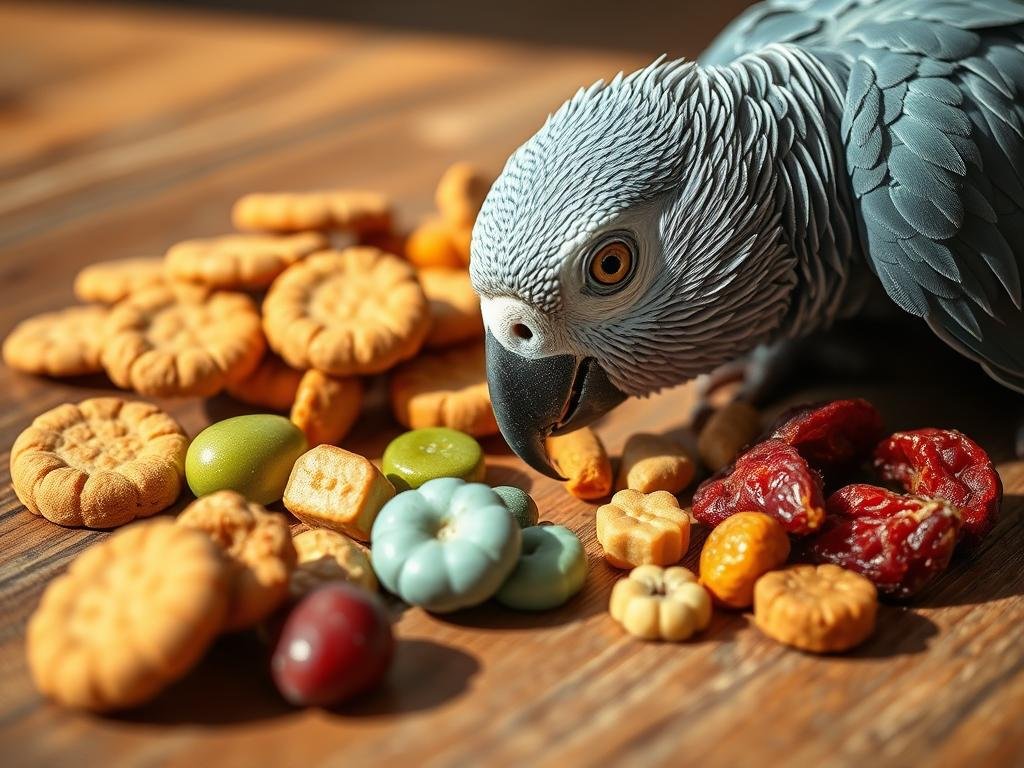
Choosing the Right Treats
Not all rewards are equal. Rank them by effectiveness:
- Pine nuts (highest value)
- Sunflower seeds
- Fresh grapes (cut into small pieces)
Dolly, for example, responded better to head scratches than food. Experiment to find what motivates your bird most.
Verbal Praise and Affection as Rewards
Enthusiastic phrases like “Good bird!” reinforce progress. Pair praise with a bridge signal (e.g., saying “good” before giving a treat) to build anticipation.
Keep sessions lively but short. Overfeeding calorie-dense treats can lead to health things—moderation is key.
| Reward Type | Best For | Tip |
|---|---|---|
| Food Treats | Quick reinforcement | Use tiny pieces |
| Verbal Praise | Daily interactions | Use upbeat tones |
The best way to maintain interest? Mix rewards unpredictably—your parrot will stay engaged.
Teaching Your African Grey First Words
Building a strong vocabulary starts with simple, easy-to-pronounce words. These foundational sounds help your bird gain confidence before tackling longer phrases.
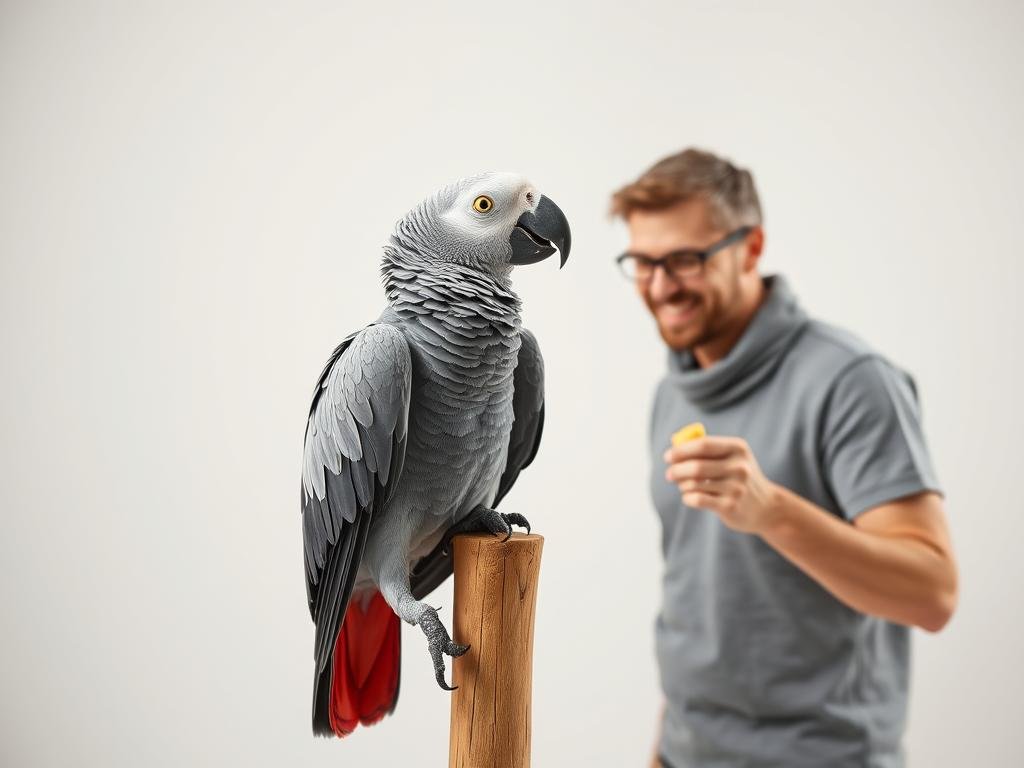
Simple Words to Start With
Begin with short, punchy words emphasizing plosive sounds like “p,” “b,” or “t.” These are easier to mimic. Top starter choices:
- Hello (high-frequency, clear vowels)
- Bird (simple consonant-vowel pairing)
- Peekaboo (playful, repetitive sounds)
- Up (useful for step-up commands)
- Scratch (bridges to physical interaction)
Building Phrases Gradually
Once your parrot masters single words, combine them. For example:
- Pair “hello” with “pretty bird”.
- Use “good bye” when leaving the room to contextualize.
Dolly learned “Wookywoo” for her toy, showing how phrases can link to objects.
Safety tip: Avoid teaching personal details like addresses. Stick to fun, functional language.
Common Challenges and How to Overcome Them
Training a parrot isn’t always smooth sailing—some hurdles require patience and strategy. Whether your bird is shy or unresponsive, small tweaks can reignite progress.
Dealing with Shyness or Fear
Sudden movements or loud noises often trigger fear. Start with *gradual exposure*—approach the cage for just 15 seconds a day, increasing time slowly.
Watch for stress signs like feather plucking or aggression. These signal unmet emotional needs. For Wookywoo, bad training caused hand fear—reversing it took weeks of treats and calm interactions.
When Your Parrot Isn’t Responding
First, rule out health issues or boredom. These things can stall learning. Ensure 5+ hours of daily mental stimulation to prevent depression.
Stick to a reliable schedule. Parrots thrive on routine, reducing fearfulness. If progress stalls, consult experts like Dallas Parrots for tailored advice.
| Challenge | Solution | Tip |
|---|---|---|
| Fear of hands | Offer treats from afar, then closer | Use sunflower seeds |
| Ignoring commands | Shorten sessions to 10 minutes | End on a success |
- Identify triggers: Noises, new objects, or fast movements.
- Desensitize slowly: 15-second daily steps build confidence.
- Check environment: Avoid tall cages or noisy areas.
Advanced Techniques for Expanding Vocabulary
Once your parrot masters basic words, it’s time to level up their speech skills. Advanced methods can help them learn complex phrases and even mimic everyday sounds. With the right approach, your feathered friend can develop an impressive vocabulary.
Incorporating Songs and Sentences
Music is a powerful tool for teaching longer phrases. Start with simple tunes like “Happy Birthday,” breaking them into short lines. Repeat each line slowly, rewarding attempts with treats or praise.
For best results:
- Use melodic repetition: Sing the same line 5–6 times per session
- Pair with actions: Wave when teaching “hello” to create associations
- Keep it fun: Choose songs your bird seems to enjoy
Using Environmental Sounds to Inspire Speech
These clever birds naturally copy household noises. When the phone rings, say “phone!” clearly. This sound association helps them connect words to real-life events.
Other effective techniques:
- Record training sessions and play them during the day
- Reward only intentional speech, not random noises
- Aim for 50+ words by year two as an advanced goal
| Technique | How It Helps | Tip |
|---|---|---|
| Song Training | Builds phrase memory | Use simple, repetitive tunes |
| Sound Association | Links words to objects | Be consistent with cues |
| Audio Looping | Reinforces learning | Keep volume moderate |
For more expert advice on expanding your bird’s ability to communicate, check this comprehensive guide. Remember, patience and creativity are your best tools for success.
Real-Life Success Stories
Watching a once-quiet parrot transform into a vocal companion is one of the most rewarding experiences for owners. These journeys prove that with the right approach, even hesitant birds can flourish.
Dolly’s Journey from Silence to Chatter
Dolly, a timid Congo grey, went from zero words to 15 phrases in just six weeks. Her owner used stool proximity training—rewarding her for stepping closer during sessions.
Key milestones:
- Week 1–2: Bonding with treats and name recognition
- Week 3–4: First mimicked words (“hello,” “up”)
- Week 5–6: Contextual phrases like “scratch please”
Apollo, another star pupil, mastered colors and materials using the model/rival technique—earning pistachios for correct answers.
Lessons from Other Owners
Dallas Parrots reports an 89% success rate with structured 6-month programs. However, common pitfalls include:
- Inconsistency: Skipping daily sessions slows progress
- Negative reinforcement: Scolding creates fear, not learning
- Rushing: As Barbara Heidenreich advises, “Let the parrot set the pace”
For those inspired to start their own journey, Dallas Parrots offers adoption services to match you with the perfect feathered friend for your home. Unlike a dog, these birds thrive on mental challenges—making their progress even more impressive.
Conclusion
Building a strong bond with your parrot takes time, but the results are worth it. Start early, use clicker tools, and reward small wins to encourage progress. Some birds may take 12+ months to speak, so patience is key.
For expert guidance, explore Dallas Parrots’ programs. Their methods help birds like Alex learn words with meaning.
Your chatty companion awaits! With consistency and care, you’ll unlock their incredible potential.
0 Comments